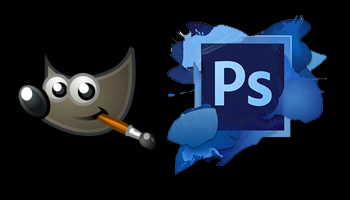In this series by TechWench we are looking at some of the basics of producing Professional Digital Imagery, previous articles in the series have covered the basic principles of image manipulation and some of the software packages available to achieve this. This article will be comparing the two major pro-tools used by the industry, Photoshop and GIMP.
The following software packages are overflowing with features, far more than you could possibly need in a single image alone. As such they can require a bit of getting used to, being designed for professional use, they require a significantly wider range of options than free packages such as iPhoto or Picasa. Learning to use these packages properly will take you some time and possibly a book or two, mastering them is something that will take you far more time and far more books.
Adobe Photoshop
Adobe Photoshop is the de-facto standard software package for digital image editing and manipulation. Any job requiring some element of graphic design or image manipulation will require at least a familiarity with Photoshop, so powerful are its features. This is perhaps why its name, Photoshop, has become synonymous with image alteration and modification worldwide. One can use Photoshop to take a blank canvas all the way up to a photo realistic painting and everything in between; when it comes to still images its possibilities seem limitless. That being so it is also quite a cavernous piece of software with any number of tweaks hidden amongst its multiple menus. It is highly valuable for its worth as a training ground for learning some of the simpler techniques; resizing, recoloring, converting between formats and cropping, whilst being able to take you further into the world of 3D buildings, seamless blending and stunning colours should you want.
If the world of Photoshop seems a bit daunting to you then fear not as Adobe is designed with learning in mind and catalogues of how-to’s are available on their website and there is also a wide community base which can service your requirements, simply ask!
Compatible with both Mac’s and PC’s it can be a bit of a drain on resources with a gigabyte of RAM being the recommended minimum but it depends on what you are trying to achieve. Photoshop can handle large files with many layers of alterations but you may find your computer slowing if you push the software to do high-resource alterations. Where Photoshop can really show its worth is in its batch processing options, allowing you to commit one alteration to a whole section of photos, useful when watermarking your images or batch resizing your images for web. This can be such a timesaver in itself when used correctly that it will leave you wondering how you got by without it.
The software works with a system of layers, you take your source image and then add subsequent layers on top which leave you with the final result. What is contained in these individual layers is entirely unbounded, especially with the development of Photoshop’s video handling capabilities, Photoshop can serve as a stand-alone all in one media editing package(except for audio). For all these reasons and more it is the industry standard package and also one of the most highly pirated piece of software, primarily due to its highly limiting price.
For this bloggers advice, Photoshop is well worth learning and can serve you well in many areas of industry. You may be able to learn it in the office as many organisations may have an older copy installed and the basic tools have remained the same within Photoshop over the past few iterations of the software. If however you do not like the sound of the associated price tag for Adobe Photoshop ($699 for home use) which many do not then there are other professional tools available to you without the heady price tag.
GIMP
At the other end of the professional package range is GIMP but is not one to be overlooked, despite its misleading price tag of Free. Designed and released as an open source image editing package to enable everyone to become familiar with image alteration methods it is a worthy competitor to Photoshop in many aspects. Most image alteration processes are catered for in GIMP but getting around the software considerably hinders its ease of use as its interface is not the most welcoming, especially to the beginner. That being said it still has options for batch processing should you require it and is an excellent tool for familiarising yourself with the world of image editing. Most use it as a training ground before committing to Photoshop.
As we can see you do not need to commit to the full price of Photoshop to get much of the same functionality though GIMP is somewhat of a gateway software and once you become aware of its limitations you will find yourself wanting to flex your fingers some more. In the next article we will cover some of the basics of colour correctionand really begin to get to grips with image manipulation and creating Professional Digital Imagery.











Comments